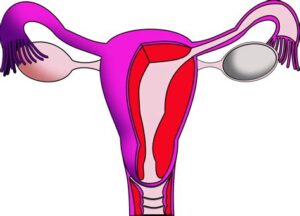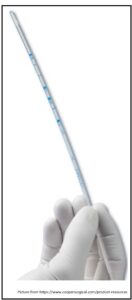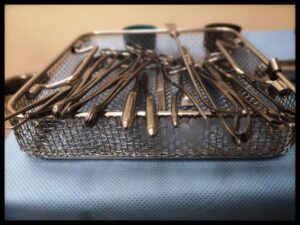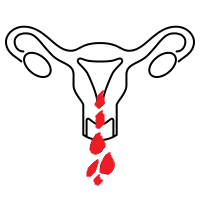 Endometrial biopsy is a procedure that involves the removal of tissues from the endometrium, which is the inner lining of the uterus.
Endometrial biopsy is a procedure that involves the removal of tissues from the endometrium, which is the inner lining of the uterus.
Reason for the procedure
It is done to diagnose endometrial cancer or hyperplasia (with or without atypia). Endometrial hyperplasia is a potentially precancerous condition. This procedure is indicated in a woman with abnormal uterine bleeding. This includes bleeding between menstrual periods, excessive bleeding during a menstrual period, or bleeding after menopause. It is also done to exclude endometrial cancer in post-menopausal women with abnormal endometrial finding on ultrasound scan of the uterus.
Procedure
There are 2 ways to obtain the endometrium tissues:
 1. Endometrial sampling (Outpatient clinic)
1. Endometrial sampling (Outpatient clinic)
This is usually performed in the doctor’s clinic with little or no anaesthesia necessary. The woman will lie on her back, in a similar position as for Pap Smear (Thin Prep) examination. A speculum is inserted into the vagina to bring the cervix into view and to hold the walls of the vagina open. In some cases, it is necessary to use a tenaculum (a hook-like instrument that holds and helps stabilize the cervix). A small, thin, pliable straw-like tubing (called pipelle aspirator) is used to aspirate out a small amount of tissue by inserting it through the cervix into the uterus. This is called endometrial sampling.
2. Endometrial curettage (done in operating theatre)
This procedure is usually done in conjunction with a diagnostic hysteroscopy. Previously, it is often called a dilatation and curettage (D & C). The hysteroscope is a small lighted telescope used for visual examination of the cervix and the uterus to help diagnose and treat abnormalities in the cervical canal or the uterine cavity. In the operating theatre, the vagina is cleansed with an antiseptic solution before inserting the hysteroscope. The hysteroscope can show the presence of submucous fibroids or polyps in the uterine cavity. Following hysteroscopic examination, a small curette is used to scrape against the inner lining of the uterus to gather the endometrial tissues for histological examination. Sometimes, the opening of the cervix may be very small and needs to be dilated with special dilators before inserting the curette.
Expected outcome
 The outpatient procedure (endometrial sampling) is usually straightforward, and you can return to work immediately if you want to. Sometimes, slight uterine cramping may be present and responds well to simple pain-killer medications. If the procedure is done in an operating theatre with general anaesthesia (endometrial curettage), you will need to rest at home for at least one day. In the first week following the procedure, you should expect slight per vaginal bleeding. The laboratory examination will generally determine if there are any abnormal cells found in the uterine lining. A normal (or negative) result will show no cancerous or precancerous cells. However, there is a small chance of a false-negative result. If the histology is abnormal, your health care provider will discuss further testing or treatment options.
The outpatient procedure (endometrial sampling) is usually straightforward, and you can return to work immediately if you want to. Sometimes, slight uterine cramping may be present and responds well to simple pain-killer medications. If the procedure is done in an operating theatre with general anaesthesia (endometrial curettage), you will need to rest at home for at least one day. In the first week following the procedure, you should expect slight per vaginal bleeding. The laboratory examination will generally determine if there are any abnormal cells found in the uterine lining. A normal (or negative) result will show no cancerous or precancerous cells. However, there is a small chance of a false-negative result. If the histology is abnormal, your health care provider will discuss further testing or treatment options.
Risks
Endometrial sampling is unlikely to be associated with any risks. If the procedure is performed under anaesthesia (endometrial curettage), with or without the diagnostic hysteroscopic examination, the possible complications are:
- Excessive bleeding.
- Endometritis (a rare infection of the uterus).
- Inadvertent injury to the uterus (uterine perforation) or the cervix.
Post-procedure care (for endometrial curettage)
- Bathe or shower as usual.
- The biopsy may cause a small amount of bleeding (spotting). Wear sanitary pads and avoid tampons temporarily which may lead to infection. Your menstrual flow may be heavier than usual.
- Wear a pad or panty-liner for few days.
- Do not douche unless it is prescribed for you.
- There is no specific dietary restriction.
Medications
- Hormones may be prescribed to manage your abnormal menstrual bleeding.
- You may have uterine cramping pain following the procedures, usually lasting for few hours and up to a few days. You may use non-prescription drugs, such as paracetamol or any nonsteroidal anti-inflammatory drugs (NSAIDs) for the pain.
 Activity
Activity
- Office procedure (endometrial sampling) – you can return to work on the same day or take a day rest if you feel uncomfortable.
- Endometrial curettage – resume daily activities, work or driving as soon as possible. This is usually possible after 1 to 2 days later and when you feel well.
- You can resume sexual relations when spotting ceases.
 You should see your doctor immediately if you have:
You should see your doctor immediately if you have:
- Vaginal discharge increases or begins to have an unpleasant odour.
- You experience cramping or pain that simple medication does not relieve quickly.
- Abnormal heavy vaginal bleeding or fever develops.
To print a pdf copy, click HERE
Please subscribe below for more information via the newsletter.
[mailerlite_form form_id=3]



